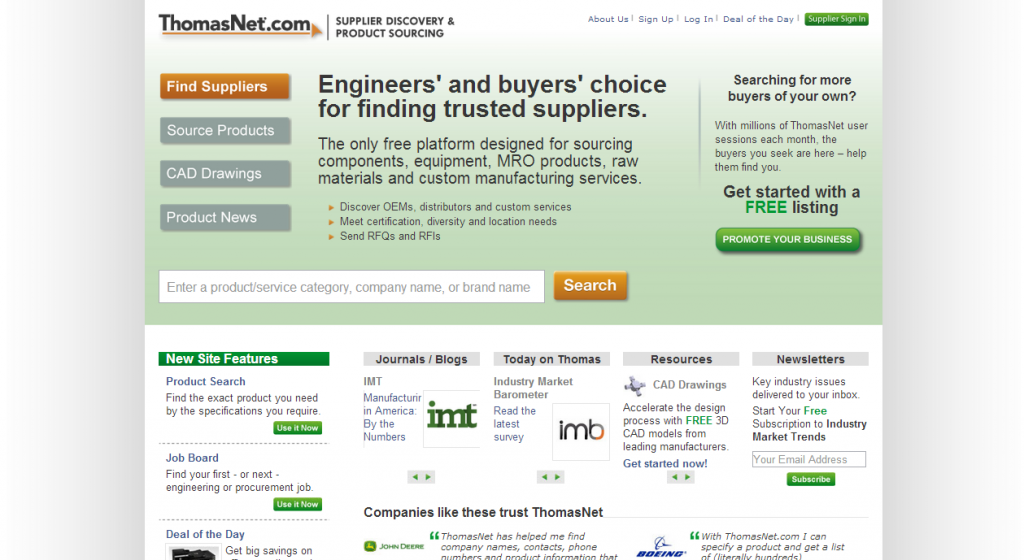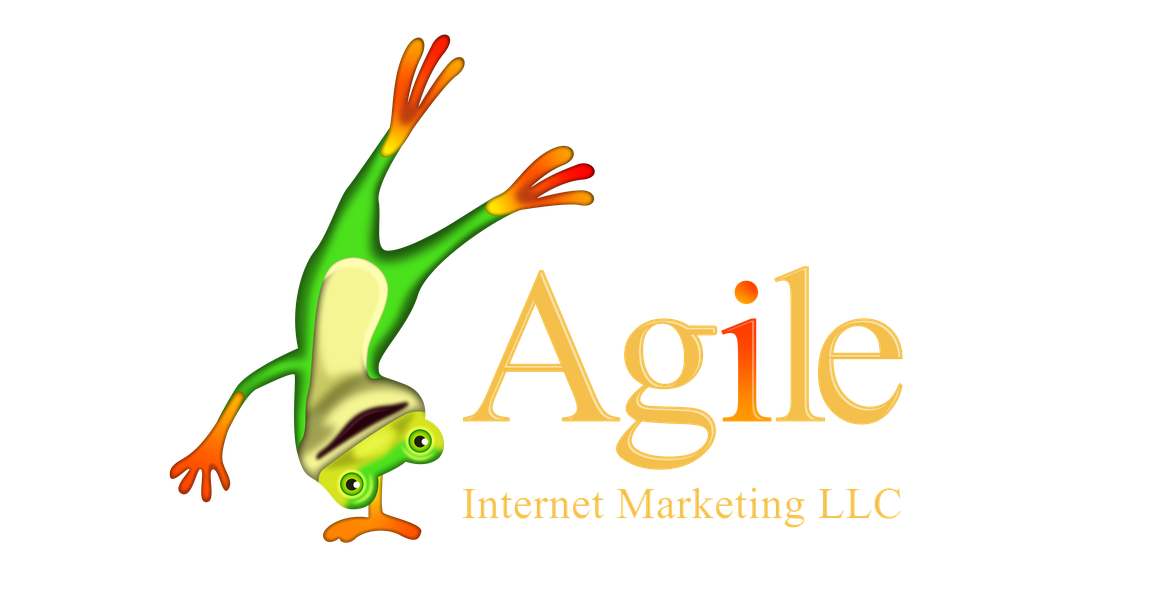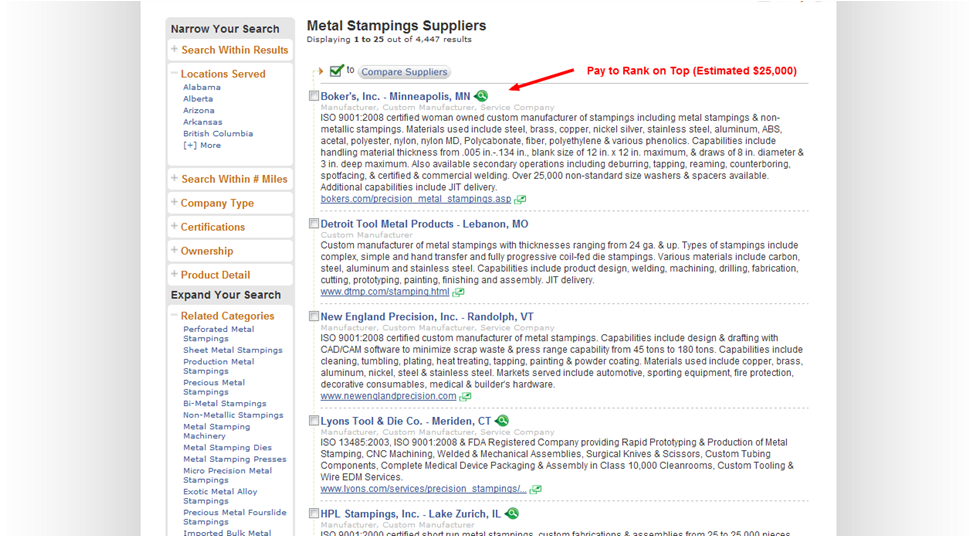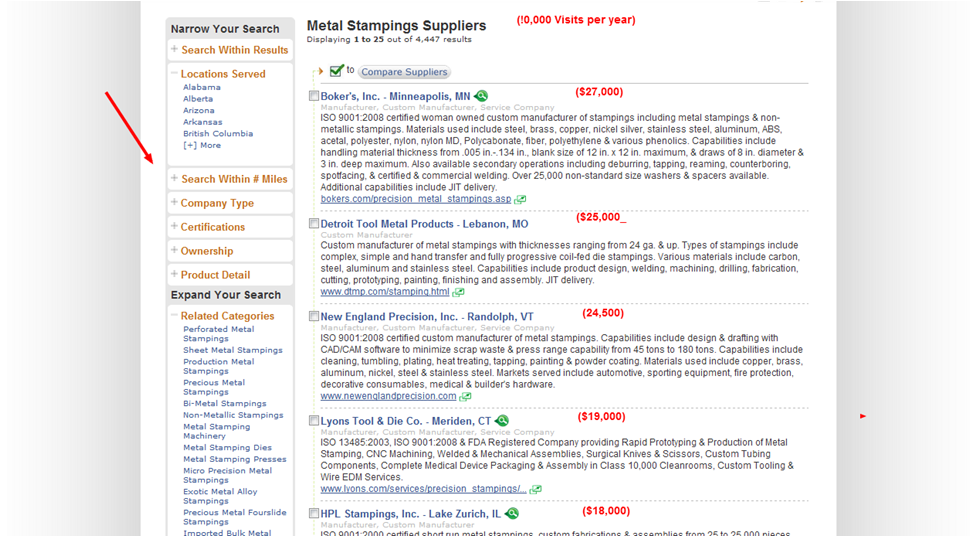by Kevin Burke
Overview
ThomasNet is the granddaddy of Industrial Directories established over 100 years ago. The “Big Green Books” as they were called in most companies, adorned the walls of most Purchasing Agents and Engineers across the country. Thomas Register was considered the “Bible” for sourcing industrial suppliers and very few manufacturers did not have some presence in the books. The company is still privately held and does not disclose annual sales figures.
The Internet changed that stranglehold and niche Thomas enjoyed and the company started to diversify online finally eliminating the books in 2005. Today the site lists over 600,000 supplier in 67,000 product categories. Thomas also branched out in to Web Publishing Services including websites, proprietary Catalog Management System, CAD, and a Newsroom.
How the Programs Work
While ThomasNet has expanded the array of offerings, the great majority of revenue is from Directory listings. Suppliers buy ranking under a selected Category competing on an annual basis for top ranking. For example, a Metal Stamping supplier might spend $25,000 to rank at the top of the “Metal Stamping” heading while other categories might cost only $270 to rank at the top of the page. Advertisers are displayed in order of total spending for that Category with non-paid suppliers appearing below. Each Category has a total of 25 suppliers listed on the page. Each category is a separate bid or auction. Pricing is not based on activity or clicks although advertisers are given historical data regarding activity at each heading.
Searchers on ThomasNet have a variety of options to sort results and can either click on a Company profile or link directly to the Advertisers site. Users of ThomasNet can also Monthly Activity reports are emailed to Advertisers the following months showing activity from the ThomasNet site.
Cost of Average Program
There are no specific cookie cutter programs as each Advertiser decides what and how many Categories they wish to advertise under. As noted, some headings are very competitive and may cost tens of thousands to appear on the Top 3 while lesser and more niche Categories have few if any advertisers (and traffic perhaps). Generally, the average program cost is about $7,000 per year. Programs are for a term of one-year and are not cancellable and Thomas does not offer trial programs. Advertisers may adjust programs on an annual basis. Thomas sells primarily through a network of Independent sales agents but also has expanded a direct telesales department as well. Most reps will not offer programs below $2,000 to new advertisers.
Source of Traffic and Demographics
A majority of the traffic on the Thomas site originates from either organic ranking on Google or via PPC programs. It is believed that ThomasNet has seen a decline in organic Google traffic since the Google algorithm change and Panda updates in 2011. They seem to have dramatically increased their PPC efforts since the change. Some believe as much as 70% OF TRAFFIC is via Google.
Insiders Guide
Line any marketing effort, measuring effectiveness is key but often difficult for custom manufacturers and service companies. Also, for some companies, one inquiry may result in a $100,000 order and easily justify the cost of a five figure investment. That said, let’s look at some of the intricacies of a Thomas program.
Insider TIP # 1 Ranking formula
Industrial Directories, including ThomasNet are not cheap. For suppliers who are used to spending $1 to $2.00 per click may be alarmed when they see what they pay per visitor from a ThomasNet. For the clients we manage, $70 to $100 per visitor is not unheard of. While that may seem ludicrous to some, if the traffic converts then your ROI may be justified. All the traffic in the world at $1.00 per click is worthless if it does not turn into orders. To see more on how to measure conversions see out post here
As we mentioned, Advertisers select a Category and decide how much money they want to spend to rank high on that Category. Generally a Sales Rep may share with you where each Advertiser is spending money so you can decide how to position yourself. Make sure you know the following:
Total Traffic Under that Category
Total Clicks to Advertisers Website for that Category
Spend for Each Advertiser by position.
(see graphic representation Example only. Not real statistics)
There is often a “sweet spot” where you can position yourself to maximize your rank while minimizing your spend. In this supposed example, the third ranked supplier is spending $24,500 while the fourth ranked supplier is spending $19,000. You best return would be to spend $19,500 and rank fourth. Unlike AdWords, your bid is not dynamic and adjusted to others in the process. You need to pull this information from your sales rep and take some item to analyze. Thomas actually uses points with each point costing $270 but the process is the same. Again you need to analyze
Activity at heading
Dollars/points spent at each position
Find your sweet spot.
Insider Tip #2
Analyze Only Traffic From Paid Headings
Each advertiser will be listed under the Category he is paying for as well as any related headings. For example a Metal Stamping company may buy ranking under “Metal Stamping” but may be listed under another 50 categories such as “Stampings”, Precision Stampings, Eyelets, Deep Drawing etc. While it may be a source of additional traffic beyond your paid Categories, many of the headings are very broad and will not be very relevant. Also, your ranking under these headings might be 255 out of 500 suppliers so obviously any activity would almost surely come from people prospecting on the site. The directory is very complete and is used as a prospecting tool so much of that activity may be the China or salespeople variety. With an Internet program you must separate the wheat and the chaff, when you analyze your Investment, you only want to include relevant traffic that you are buying.
Insider Tip #3
Measure Measure Measure. Pick your important Analytics and make sure you measure what is effective. For most of our clients, it is all about driving qualified Inquiries that turn into sales.
If you are an advertiser you want to insure you have a quick way to determine how many online Inquiries are generated by each Source. How many quotes are coming in from ThomasNet vs. Google vs. Global Spec etc.
See this screen capture which can be quickly set up in Google Analytics and allows you to track where points of contact are coming from. While phone calls are another discussion, this gives you a powerful metric to determine effectiveness of each marketing channel.
At a glance you can see where your online Inquires are originating from. Offline calls will usually mimic these numbers and your salespeople can find out more as to whewre they found you (although not always as accurate in retelling).
Insider Tip #4
Position your self in the Top 3 or 5 but do not pay a premium for the top spot. Much like Adwords, being in the First Position is not always the wisest choice. Many engineers and sourcing professionals are savvy Internet users. They are capable of narrowing a search down with “their eyes” as well as with a mouse. Location, name recognition, capability, past association may all play a role in deciding which result (or results ) to click on. Generating a bunch of traffic that does not convert helps no one. Be wise and try and find a sweet spot that will garner the MOST QUALIFIED PROSPECTS as opposed to raw numbers.
Bottom Line
As with any Internet Marketing venture, you need to set goals and the ability to track those results. ThomasNet can be very expensive but if it brings a high dollar sales return, then it may be worth the risk. Remember these points in either a new or established program.
-Follow the money (and the points.) now exactly what is being spend at each position on any category you are investing in. DON’T OVERSPEND
-Make sure the Categories are Relevant and generate significant traffic.
-Set up tracking so you know exactly how many online Inquiries are being generated.
-Compare the cost of Adwords vs the Category you are advertising in. For example, look to see what it would cost to buy the term “Metal Stamping” on Google vs the pay-per-click cost fro Thomas Net. While the conversion rate from these two channels may be different, it is a metric worth knowing.
Conclusion
We help our clients analyze their Thomas Net programs on a regular basis. In many cases we can save significant money while improving the performance of the program and instituting tracking to insure results. If you do not have the time to perform these steps yourself, give us a call to see how we may be able to help.
Call us to discuss your ThomasNet program and your Internet marketing objectives at 508-320-2625
In 0ur next Installment we look at GlobalSpec





Kevin:
As you know I work at ThomasNet. I would like to point out to your readers that they may read what real users of ThomasNet.com say here http://www.thomasnet.com/testimonials and that they may see and hear what some of ThomasNet’s clients say here http://www.youtube.com/user/ThomasNetVideo .
Brendan
Good point Brendan. I am simply trying to point out how the programs work and ways for companies to maximize their investment and measure results. Thanks for sharing.
Hi Kevin,
Thank you for your unbiased insightful overview of both ThomasNet & GlobalSpec. I work for Thomas Publishing and am proud to represent this fine company.
Thanks for writing. And we are proud to provide additional insight (or at least opinion) on the Industrial Internet marketing scene. Hope you read the next installment when we look at some of the other smaller players in the Industrial Directory world.
Hi Kevin, Great article, had a couple of questions:
1. $70 to $100 per lead website visit is very high. Do you know home many page views a typical category page that costs $24000 get? Or how many page views does one that costs $250 get.
2. If most people find thomasnet through google – Then wouldn’t it be more economical to target those same users via google before they get to thomasnet? This way you can get the same users at a much lower cost.
1) Every page/category is different….some have high traffic and not many advertisers and others have a lot of competition for fewer visitors. The cost is high so it really depends on your conversion rate and what an order or customer is worth. For some Industrial advertisers, a single order may be worth hundreds of thousands of dollars. For others it is simply too costly.
2) Yes….Google Adwords and SEO may be a much more feasible alternative for many companies.
Taking that $24,000 you speak of and spending it on promoting your website direct through SEO, Social, Email mktg, press releases etc… is a MUCH better way to promote your business
We are a strictly industrial ad/PR agency in Chicago and have run dozens of clients in TN over the years. All above comments are quite true and the results do vary greatly, as we handle fastener clients who get 20,000 leads annually and capital equipment clients who get 1000, yet both are satisfied. Unlike the consumer world, ours is not about numbers, it’s about value and timeliness. Just the other day, I sat with our largest media client (120 trade magazines on the schedule) and reviewed some current customer projects. Upon returning to the office, I quickly checked their TN Client Center, a great tool, and found six of the 12 companies we’d discussed, who’d recently hit our guy’s listings. QED. Probably $2 million in biz, just from those guys.
Tim,
Thanks for the comments. I agree that clients can receive real value from ThomasNet. Much depends on how good the rep is and if they are trying to maximize the clients value, or their own interests. When dealing with our clients, we often find we can reduce the ThomasNet investment while increasing visits and conversions, not unlike a Google Adwords program that is not well constructed or adjusted on a regular basis.